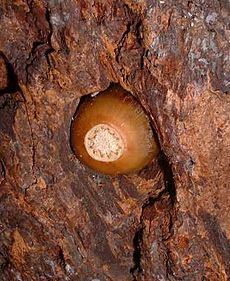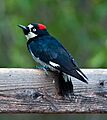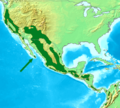Acorn woodpecker facts for kids
Quick facts for kids Acorn woodpecker |
|
|---|---|
 |
|
| Male in California, United States | |
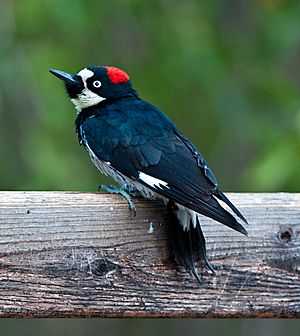 |
|
| Female in Arizona, United States | |
| Conservation status | |
| Scientific classification | |
| Genus: |
Melanerpes
|
| Species: |
formicivorus
|
 |
|
| Range of M. formicivorus | |
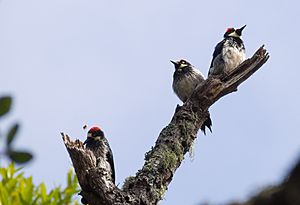
The acorn woodpecker (Melanerpes formicivorus) is a medium-sized woodpecker. It is about 21 cm (8.3 in) long. An average acorn woodpecker weighs around 85 grams (3 oz).
Contents
About the Acorn Woodpecker
Scientists first described the acorn woodpecker in 1827. An English scientist named William Swainson gave it its scientific name, Picus formicivorus. Its scientific name, formicivorus, means 'ant-eating' in Latin. This bird belongs to a group of woodpeckers called Melanerpes. This group includes 24 different species.
What Acorn Woodpeckers Look Like
Adult acorn woodpeckers have a brownish-black head, back, wings, and tail. Their forehead, throat, belly, and rump are white. They have bright white eyes. You might also spot some green feathers on the lower part of their backs.
Male and female acorn woodpeckers look a bit different. Males have a red cap that starts right at their forehead. Females have a black area between their forehead and their red cap. The white patches on their neck, throat, and forehead help tell them apart.
When these woodpeckers fly, they flap their wings a few times. Then they drop down a bit before flapping again. You can see white circles on their wings when they are flying. Acorn woodpeckers also have a call that sounds almost like they are laughing!
Here are some average measurements for acorn woodpeckers:
- Length: 19-23 cm (7.5-9.1 in)
- Weight: 65-90 g (2.3-3.2 oz)
- Wingspan: 35-43 cm (13.8-16.9 in)
Where Acorn Woodpeckers Live
Acorn woodpeckers live in forests with oak trees. You can find them in the coastal areas and foothills of Oregon, California, and the southwestern United States. Their habitat stretches south through Central America all the way to Colombia.
In the northern parts of their range, they can live in lower areas. However, in Central America, they usually live above 1,000 meters (3,300 ft) elevation. They build their nests in large holes they dig in dead trees or dead parts of trees.
Acorn Woodpecker Life and Habits
How Acorn Woodpeckers Raise Their Young
Acorn woodpeckers often live in groups that help raise the young. This is called "cooperative breeding." It's quite rare in birds, happening in only about nine percent of bird species. These groups can be made of a single pair or several adults.
Sometimes, several adult acorn woodpeckers, called a "coalition," nest together. They often choose places near their acorn storage areas. Also, young woodpeckers sometimes stay with their parents. They help take care of their younger brothers and sisters. Scientists believe that having limited places to store acorns makes these birds work together.
Breeding groups can have up to seven male woodpeckers and three female woodpeckers. However, most nests have about three males and two females. These groups can also have up to ten young helpers. The adults in these groups are usually related. For example, the males are often brothers, and the females are usually sisters. But male and female co-breeders are almost never related to each other.
If there is more than one female in a group, they lay their eggs in the same nest hole. A female will usually destroy any eggs already in the nest before she starts laying her own. Once all the females begin laying, they stop removing eggs. It's common for chicks in one nest to have different fathers.
What Acorn Woodpeckers Eat
As their name suggests, acorn woodpeckers eat a lot of acorns. Acorns are so important to these birds in California that they sometimes nest in the fall. This lets them use the fresh acorn crop, which is unusual for birds.
Acorn woodpeckers also eat insects, tree sap, and fruit. You might see them flying from tree branches to catch insects in the air. They also eat seeds and drill holes to drink sap from trees.
In some areas, like California, these woodpeckers create special "granary trees." They drill many holes in dead trees, branches, telephone poles, or wooden buildings. They also make holes in the thick bark of living trees, like the Ponderosa Pine. These holes are always above the snow line so the acorns can be reached in winter. Hundreds of these holes can be seen on large trees, and they do not harm the tree.
The woodpeckers collect acorns and find a hole that fits each one perfectly. As the acorns dry out, they shrink. The woodpeckers then move them to smaller holes. Keeping these granaries in good shape takes a lot of their time. The stored acorns are visible, and the group defends its granary. They protect it from birds like Steller's jays and western scrub jays, who might try to steal their food. If a woodpecker group loses a member or its leader, other woodpeckers from nearby areas will rush in. They fight for access to the stored acorns. These fights also attract other woodpeckers who come to watch the battles.
In other parts of their range, acorn woodpeckers do not build granary trees. Instead, they store acorns in natural holes and cracks in tree bark. If their stored food runs out, the woodpeckers will move to another area. They might even travel from Arizona to Mexico for the winter.
Threats to Acorn Woodpeckers
Acorn woodpeckers, like many other animals, face threats from losing their homes. Their habitats are being destroyed or changed. In cities, other bird species sometimes compete with them for nesting spots.
To help these woodpeckers, we need to protect healthy forest areas. These forests must have plenty of oak trees that produce many acorns. They also need places for the woodpeckers to nest, rest, and store their food. People are encouraged to keep mature oak and pine-oak trees. Providing dead branches and snags (standing dead trees) can also help. These provide places for nesting, roosting, and granary sites. This helps keep the acorn woodpecker population strong.
Images for kids
See also
 In Spanish: Carpintero bellotero para niños
In Spanish: Carpintero bellotero para niños




